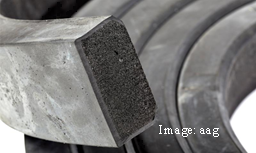The Drill Down, Issue #13: Class 1 Watertight Door Gaskets
 Introduction
Introduction
Class 1 watertight doors (WTD) are a critical part of a vessel's watertight subdivision, and consequently, a crucial part of damage stability considerations. This issue of Drill Down explores the mechanics, materials, and inspection considerations of the gasket material of Class 1 WTDs.
Definitions
Class 1 WTDs: a "hinged door" with a quick action closing device operable from both sides of the door.
Dogs: mechanical actuators that force the door against the knife edge to hold it closed and able to resist water or air pressure.
Durometer Hardness (shore): the hardness of a material, typically of polymers, elastomers, and rubbers. Higher numbers on the scale indicate a greater resistance to indentation and are typically harder materials.
Watertight: means designed and constructed to withstand a static head of water without any leakage.
The Function of the Gasket
As the term implies, a WTD, when properly closed, forms a watertight seal. When the dogs on the door are seated or "dogged down," the gasket in the edge of the door presses against the knife-edge around the door frame. The WTD must be able to withstand a minimum head of 10' to accomplish a watertight seal, though the design head can increase depending on the installation location.
Gasket Material and Properties
Marine Safety Manual Vol II states the gasket on a WTD shall be "flexible to provide a seal." The term "flexible" is not defined and is left open to interpretation. For this discussion, "flexible" means the gasket material (neoprene, rubber, or silicon) should have the appropriate shore to provide a seal against the knife edge when dogged down. However, there should be no damage to the gasket when dogged down, allowing the material to compress and expand when appropriate.
Gasket material, due to its unique properties, can be subject to embrittlement, shrinkage, and other effects that degrade performance. These effects can be mitigated by proper installation and maintenance during the service life of the gasket. Gaskets should be clean and free of paint or other foreign material that could prevent an adequate seal and damage the gasket.
There are no "one-size-fits-all" applications for Class 1 WTD gaskets. In many instances, the original equipment manufacturer (OEM) will recommended a specific gasket. The OEM incorporates multiple factors when determining gasket hardness and composition such as ambient temperature, potential chemical exposure, and the construction/functionality of the door.
Inspection Considerations
The inspection of Class 1 WTDs should be a priority of all Marine Inspectors (MI) regardless of the vessel's inspection scheme.
If the MI has reason to suspect any component on the Class 1 WTD is preventing the door from operating or functioning as designed, the MI should work with the vessel representative to address those concerns and ensure compliance. Vessel representatives are encouraged to consult the OEM for recommended replacement parts or suitable alternatives.
Additional Information
For more information about WTD safety please visit the following link for a series of USCG Marine Safety Alerts: